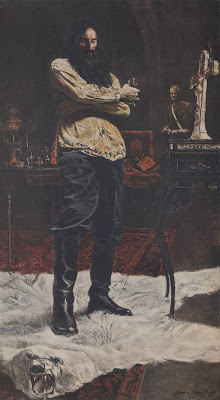
Critics argue constantly about whether comic art qualifies as a fine art. Rather than debate which kinds of art win the "Fine Art" trophy, it is more interesting to compare the different strengths and weaknesses of different kinds of art.
For example, there are ways in which comics can be the ideal art form, better suited than painting or sculpture to bring out the strengths of an artist. It seems to me that no other art form in history has provided such fertile soil for true eccentrics to develop and display their personalities.
There is only a handful of truly famous eccentrics in art history: William Blake, the 18th century English mystic, recorded his dreams and religious visions in drawings and poems. Blake and his wife used to sit nude in front of guests and recite passages from Paradise Lost.

His distinctive artwork reflected his own odd personality and was not part of any school.

Other famous eccentrics include Richard Dadd, who was mentally ill, and Salvador Dali, who probably feigned being mentally ill. These noted eccentrics saw the world through a peculiar filter, often speaking in a language of their own. We pay attention because we learn something by viewing humanity from the outside.
I suspect that the comics medium has a higher ratio of true eccentrics than any other art form. George Herriman's
Krazy Kat, Chester Gould's
Dick Tracy, Gary Larson's
Far Side, Harold Gray's
Little Orphan Annie, Bill Holman's
Smokey Stover, and many other strips display deeply odd and irrational ideas, using highly personalized artwork.

Krazy Kat is not just your typical love triangle between a cat, a mouse and a dog of indeterminate gender. Herriman's art was as peculiar and insular (and profound) as Blake's. Here Herriman talks about the beginning of the world, taking a slightly different approach from Blake's biblical version.
Chester Gould's Dick Tracy is equally bizarre. In this sequence, the criminal Mr. Bribery takes a break from murder and extortion to drown his cigar smoking cat because he can't stand the cat's breath.

Bribery's sister, the aptly named Ugly Christine, gets into a fight with Bribery because she does not want him to use her new $17 steam iron as the weight for drowning the cat. As the panel at the beginning of this post indicates, the cat gets the best of Mr. Bribery.

These stories go far beyond mere whimsy. No normal mind could make this stuff up. It is like a cross between Edward Albee and the Marx brothers. And Gould's art, like Herriman's, is really good.
For a while, Gould kept a graveyard in his backyard with a tombstone for each of the villains that he killed off. In addition to his odd characters and stories, Gould regularly used his strip to lobby for crackpot causes, such as industrial control of magnetism, or not using psychics for crime detection:
Gould also diagrammed his philosophy on crime detection and other newsworthy subjects:
In the course of just 100 intense years, comics have displayed the personalities of some deeply odd people with excellent but Quixotic art-- a far higher ratio than would ever surface through art museums.
Why is this? Perhaps the medium combines the privacy for artists to sit alone at their drawing board-- a little incubation chamber for their neuroses and quirks-- with a wide daily audience for the resulting work product. Or, maybe the pressure of putting out a daily strip for decades simply drove them nuts.
































,.jpg)

